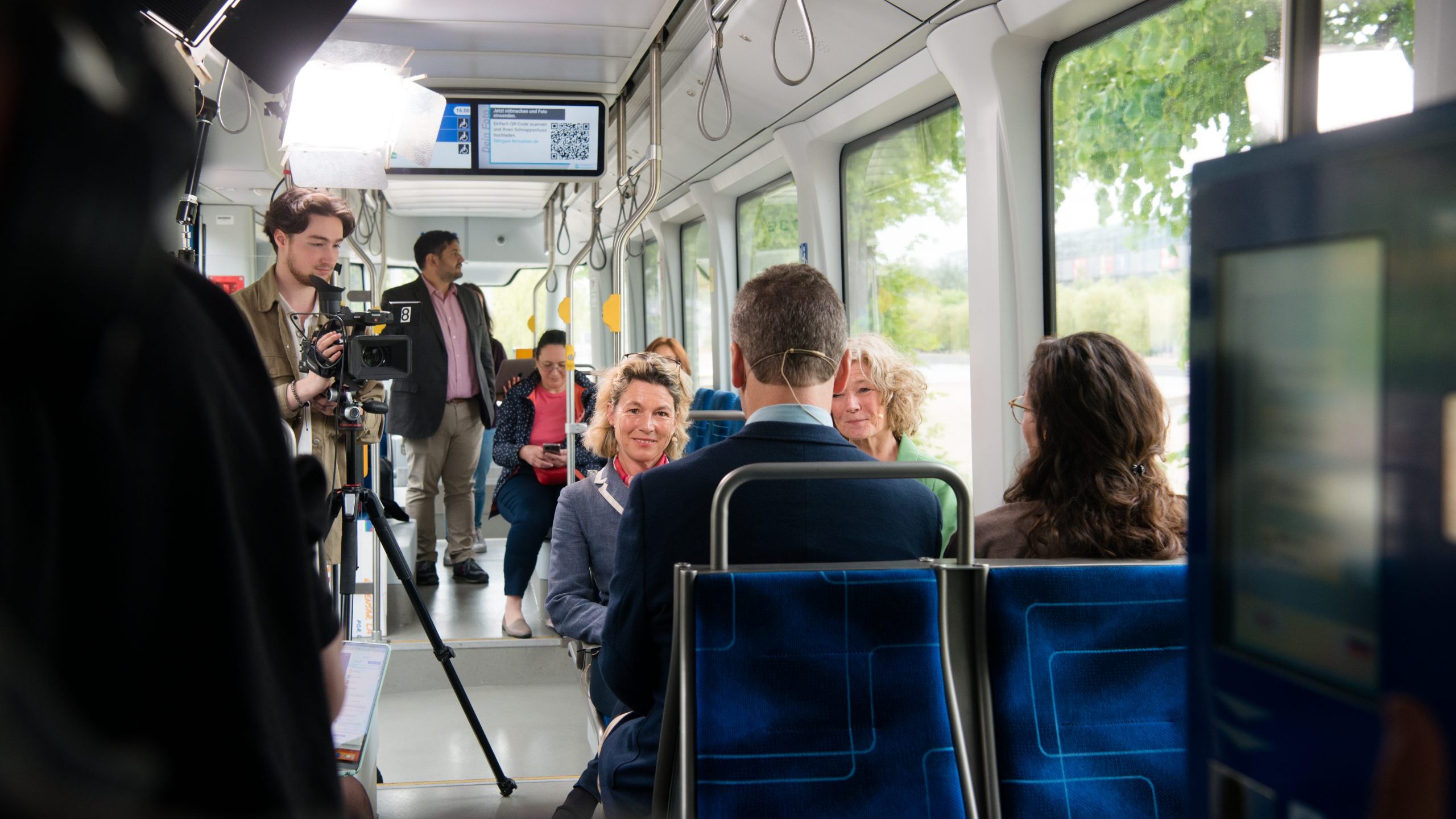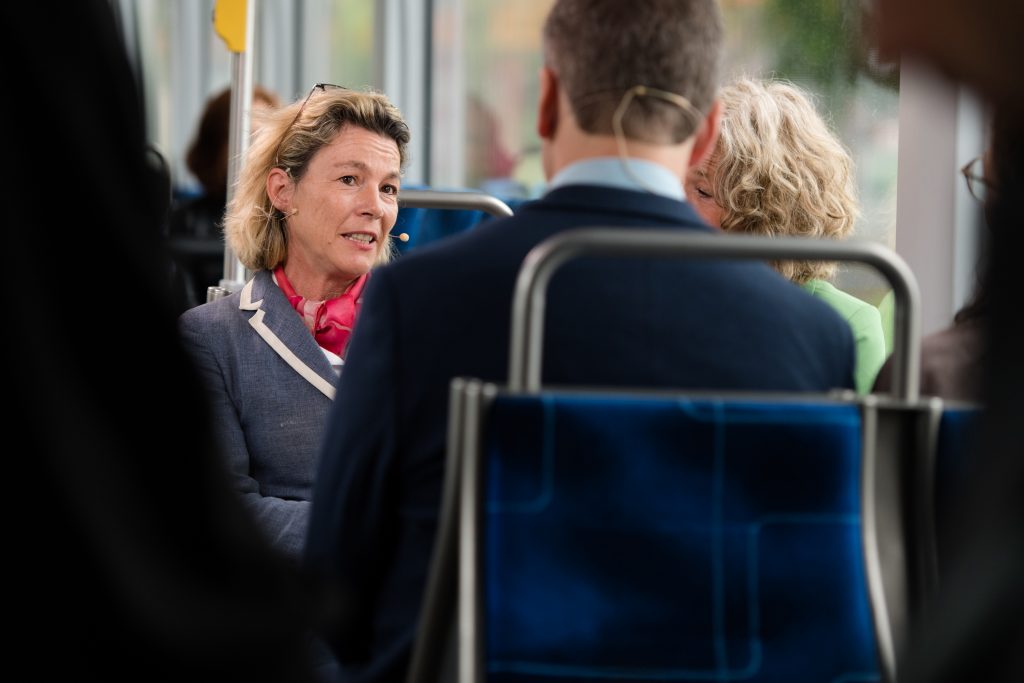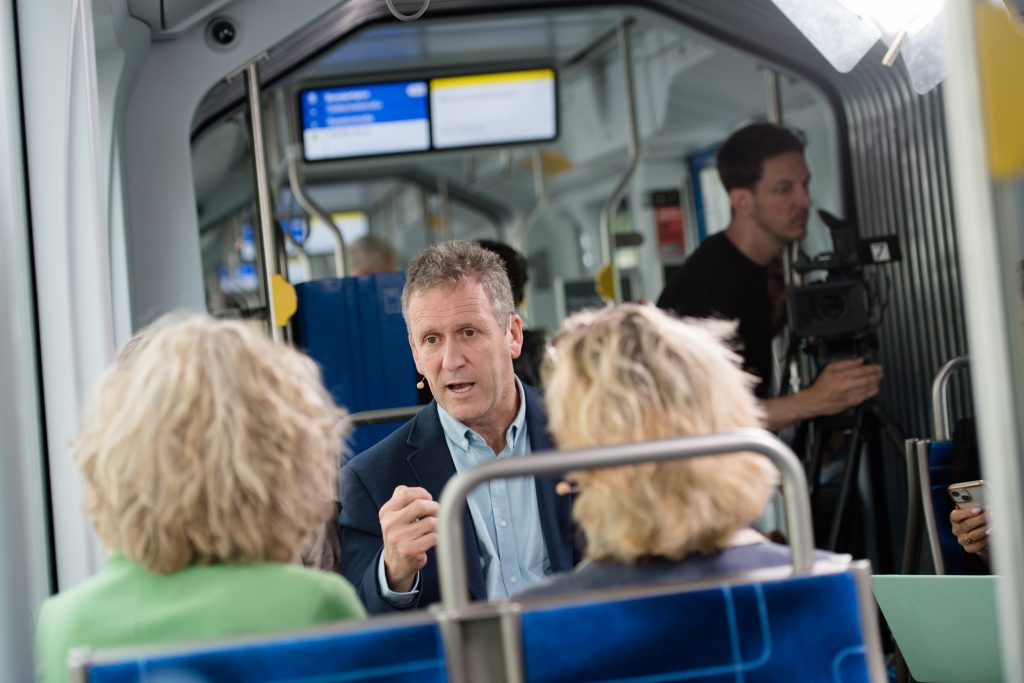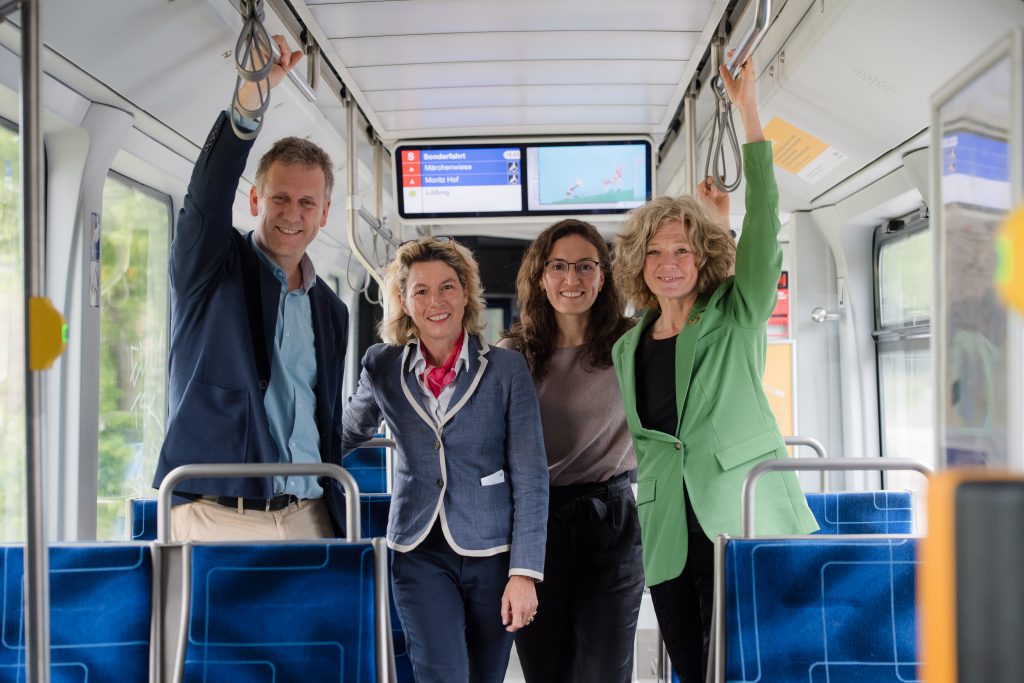
On 23 May 2023, the Alliance held a livestreamed panel discussion from a tram traveling around downtown Leipzig. The panel featured Juan Carlos Muñoz Abogabir, Minister for Transport and Telecommunications, Chile, Veronique Feypell, ITF, and Natalia Lleras, Walk21. Following from the recent UN Global Road Safety Week, the panel explored how to rethink mobility to make walking, cycling, and public transport safe and facilitate more sustainable, livable cities.
“Our cities urgently need to make sustainable transportation modes such as walking, cycling and public transport more attractive. These types of modes are beneficial to society in terms of reduction in environmental and noise pollution, urban cohesion, and traffic congestion,” says Juan Carlos Muñoz Abogabir. “[The focus is on] how our cities are organized and structured to ensure that these modes are attractive and practical to use.”
“Walking is one of the fundamental ways we move around, it is inexpensive and emission free,” says Natalia Lleras, Walk21. “However, it is often neglected in the planning and policy development of our cities. We need to provide the infrastructure and value for improving walking and to address inequities. We need to regenerate public spaces and make walking an inviting alternative to create more vibrant cities.”
“Policymakers need to think outside the box to implement actions and interventions for modal shift,” says Veronique Feypell. “We need cities with less cars and more sustainable modes of transport.”
Juan Carlos Muñoz Abogabir: The focus should be on making transport systems safer and considering other factors such as distance and time of travel within cities, which is crucial for improving attractiveness of sustainable transport modes. The shorter the distance and travel time, the more likely it is that people will walk or use more sustainable modes of transport.
Natalia Lleros: In planning our cities, we need to think about the whole trip, which starts and ends by walking. In some cities, we see nice and well-built bus stops but without safe routes to get to these bus stops.
Veronique Feypell: Making sustainable transport more attractive is crucial as without this, it is difficult to make that shift. In some cities, using public transport is more expensive than using personal cars and motorbikes and this does not help our argument for sustainable transport.
Juan Carlos Muñoz Abogabir: There are inequalities in the way people use transport systems. Those in affluent neighborhoods are more likely to have their needs within short distances unlike those in poorer neighborhoods who are more likely to take longer trips to meet basic needs. Thus, it is important we work on better distribution of opportunities and infrastructure within the city for all to benefit to make it more effective and fairer for all.
Veronique Feypell, ITF: Road crashes have huge economic costs and lead to impoverishment for many households which in turn affects other socioeconomic aspects of people’s lives and poses a huge equity problem. Investing in road safety and sustainable transport is key and provides significant returns on investment, up to 800% which is crucial for the economies of our countries.
Natalia Lleras, Walk21: In low- and middle-income countries in Africa, even though, on average, people walk more than the global average, walking is often neglected in the planning of the cities. This results in weak walking infrastructure and poor safety. Additionally, most of this walking is not by choice but people are forced to because there is no other way to get around. We need to improve walking conditions and public transport through planning and policy in these countries and create value for those who walk.
Juan Carlos Muñoz Abogabir: Enforcement is key for lower income countries to reduce road traffic incidents and fatalities. Chile was able to identify weak enforcement as the reason why the country had similar numbers of road traffic fatalities to Spain but with a population two and half times smaller. We have learnt from Spain’s enforcement model of automated ticketing to over speeding and erring drivers, and we are implementing it which we have estimated will lead to a 30% reduction in crashes and fatalities.
Veronique Feypell: We have seen the limits of traditional measures and it is great that civil society is helping and pushing us to think outside the box. For the new decade of action, we need to think innovatively about how to change urban spaces and make roads safer. We, as policymakers, are happy to listen and learn from civil society.
Juan Carlos Muñoz Abogabir: Civil society can help government by sharing innovative ideas and bringing evidence of what works: the designs, policies, operational schemes that can help us move away from motorization to more active and sustainable modes.
Juan Carlos Muñoz Abogabir: Chile is promoting citizen participation in the decision-making process by involving them in planning and designing the attributes of these public transport systems.
Veronique Feypell: This conversation around promoting active mobility is an opportunity for developing countries not to make the mistakes that developed countries made where they achieved peak motorization before realizing that this is a mistake. Active mobility should be promoted now, and the infrastructure incorporated as development continues.
Natalia Lleras: Governments need to support the implementation of innovative ideas and solutions and should collaborate with civil society to make things happen.
Juan Carlos Muñoz Abogabir: Technological innovations and innovative thinking are key to promoting modal shift. In Chile, buses have automated driver assistance systems to help drivers see blind spots better to reduce fatalities for pedestrians and other road users. To improve cycling, it has allowed cyclists to travel on the metro with their bikes on certain days of the week, and by doing this, they can use the bikes at their destination. It also has express services for some of our metro lines where the trains stop at every other station to make it faster for people to move.
Veronique Feypell: Reducing speed is clearly the number one priority for all countries and cities, and automatic speed control is an effective way to achieve this.
Natalia Lleras: In addition to speed management and enforcement, putting infrastructure to make it impossible to reach certain speeds is also crucial. We need to base road safety decisions on data to inform the implementation of road safety interventions. In Bogota we used speed management data to implement speed management intervention which led to significant reduction in crashes within six months.
Natalia Lleras: We should talk about road safety in a holistic manner and include personal safety as a component of road safety. We should address the risks people face when navigating public transport systems because these risks contribute to the utilization, or lack thereof, of these systems. Achieving this requires a participatory process to capture the concerns of the people whom these systems are designed for.


